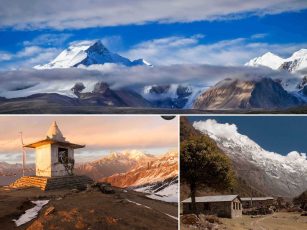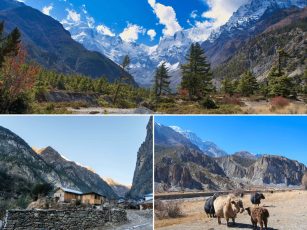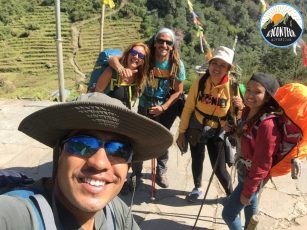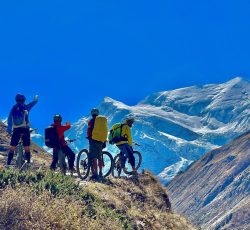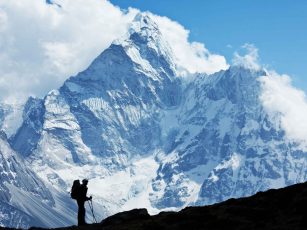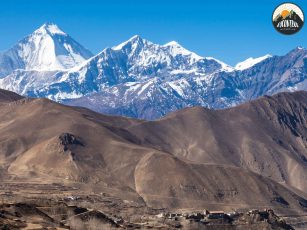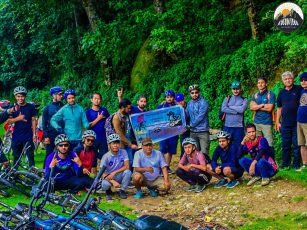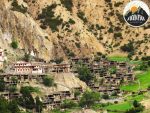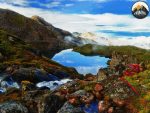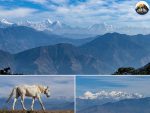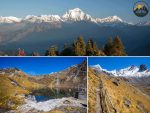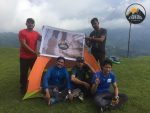Langtang Trek
Out of many trekking routes in Nepal, the Langtang trek offers some unmatchable mountainous beauty in the mid-western region of the Himalayas. British mountaineer Bill Tillman praised the beauty of Langtang as “One of the world’s beautiful valleys.” The area wears this pride of beauty, welcoming all visitors with big hearts and arms wide open.
| Trip Facts | Langtang Valley Trek |
| Duration | 11-15 Days |
| Distance | 30-40 Km(Depends on Itineray |
| Starts In | Syabrubesi,1460m |
| Ends In | Syabrubesi,1460m |
| Permits Required | TIMS, Langtang National Park, Shivapuri National Park Permit |
| Highest Altitude | 4850m |
| Difficulty Level | Medium to Difficult |
| Accommodation | Guest House, Tea House, Lodge |
| Spending | Low to Average |
| Best Season | Spring (March-May) and Autumn(September-November) |
Mind settling sceneries which are genuinely breathtaking are what you see, experience and observe during the Langtang trek. In this soul-satisfying journey to Langtang, you play with all beautiful settings rendered by green hills, forests, villages, alluring waterfalls, multi-colour rhododendron forest and, of course, high mountain peaks. Langtang valley is in Langtang National Park, and you set foot in this national park is worth it as you encounter rich flora and fauna in this part of the world. Some exotic wildlife here is Red Panda and Himalayan Thar.
In fact, for any trekking lovers, the most crucial part of any trek is, of course, the view that one’s gets to indulge in. And in the case of Langtang Trek, snow mountains Langtang Living(7227m) is a mountain to behold and savour. Langtang has a large number of Tibetan populations following Buddhism.
Langtang Valley Trek Map

Langtang Trek Itinerary
In the pool of choices to trek in Nepal, Langtang Valley Trek is an easy but equally wholesome trek experience in Nepal. The hike is short and lasts about 11 days, depending on your itinerary. The quick and moderately easy nature of this trek makes it one goes to option for first-time mountain trekkers. Trek commences from Syabrubesi, and we drive to Syabrubesi from Kathmandu. Trek begins taking you to Lama Hotel from Syabrubesi and reaches Langtang valley with additional ascends and descends. The total trek distance for the Gosaikunda Langtang trek is 19 miles or 30 km. As you hike, you can explore many impressive places along the way. Some fantastic places during the Langtang trek itinerary are Dhunche, Syabrubesi, Lama Hotel, Langtang Valley, Kyangzin Gompa and more.
Another highlight of the trek is the famous Kyanjin Gompa at 3860m, an important site of Buddhism. If you want to add more adventure to your walk, you can even summit Tserko Ri, a mini peak at an altitude of 5033m above sea level. The hardship of just a couple of hours takes you to this peak, where all pain sways away as you behold staggering mountains from Tserko Ri Peak. Standing at the peak, you will see a complete scenic view of Langtang Valley with accompanying peaks in the background.
The most noteworthy part of the Langtang region is that you have the opportunity to explore other treks and rich attractional rural mountainous settings. These attractions involve many natural sites, monasteries, Gompas, Lakes and more.
Langtang region’s famous pass is Ganja La Pass at 5130m and is one tricky part of trekking in the Langtang region. Passes in any treks done in Nepal are not easy and remember; more the hardship, more the fun and excitement.
Similarly, another attraction of the Langtang region trek is, of course, a much-sacred lake for both Hindus and Buddhists, Gosaikunda Lake. Gosaikunda Lake is a high-altitude mountain lake with beautifully changing colours and radiating positivity at an altitude of 4380m above sea level. This lake remains frozen for almost six months of a year, hence accessible only half a time of the year.
Gosaikunda lake sees its boom once a year during August as pilgrims flocks here to pay homage to God Shiva. There is even a temple to celebrate the purity and open heart of Shiva.
Kyanjin Gompa, Gosaikunda Lake. Langtang Valley is a significant attraction in the Langtang region. And the icing on the top is the never-ending richness in flora and fauna of Langtang National Park. And this national park is one of the wealthiest protected areas here in Nepal. Langtang National Park is famous for being able to protect endangered plants and animals. As you hike into the woods, you are likely to listen to the sweet lullaby of birds and excite your eyes with their colour. To the north, the national park is connected to Qomolangma National Nature Preserve, and Tibet is home to the natural park.
Things you must know before commencing the Langtang trek
Food, accommodation, safety and comfort are essential to take care of well. But remember, you have opted for a remote wilderness experience, so our initial suggestion to you would be to lower your expectations. Yes, foods and accommodation are available, and they offer basic facilities.
Food during the Langtang Valley Trek
A fresh, hygienic meal is most during any treks. So, no worries, as during the Langtang trek, you can choose Nepali, Tibetan, Indian and even Continental cuisine. On the mountainside, your accommodation is in a basic tea house or lodge, and three meals a day during the trek is what you get. And hotels are usually booked on a BB basis when you are not in the mountains. If you have any food allergies or special dietary requirements, please inform us earlier. Regular food includes Dal, Bhat and Tarkari( Steamed/Boiled Rice, Pulse Soup and Veg or Non-Veg curries). But do remember that you can choose what to eat from the menu but do confirm food options before you start to trek.

Accommodation during the Langtang trek
Most trekking routes in Nepal have lodge/tea houses offering non-heated twin sharing rooms. The lodge is hand-picked by guide experts in this trekking route. However, the agency makes booking arrangements for your comfortable night’s stay. Tea houses have a standard heated kitchen cum dining cum gathering room. In this room, travellers gather for a meal of the day. The most lodge has shared bathroom and even has hot showers. Hot showers in the mountains cost more as they are primarily solar-powered. For charging your electronic device, there are charging ports available in rooms depending on the type of lodge you choose.
How challenging is the Langtang trek? What is the required level of fitness for the hike?
Trekking that too in rough mountainous terrains is not easy. Walking in Nepal too at a high altitude is not a piece of cake. An average of 5-6 hours hike each day is what you are opting for in the Langtang trek here in Nepal. Langtang Valley Trek is not as difficult as other Everest and circuit treks, but the challenges and hardship of the Langtang trek can’t be undermined. We recommend this trek with a moderate level of fitness. But, the Langtang trek is strenuous. So, please engage in physical exercise 5 -6 weeks before the actual walk. This exercise might include swimming, cycling, short hike, hitting the gym and many more. We suggest you work on your overall stamina level.
Similarly, leg strength is of utmost importance as you are trekking. The most critical part of the trek is your mental preparation. The more you mentally prepare yourself, the more challenges get easy and wholesome.
Health is wealth. To maintain excellent health conditions up in high elevations, one needs to take care of their food and other allergies. Langtang trekking is mildly challenging, and you are being fit to ease every step you take.
What to pack for Langtang Valley Trek?
The standard trek journey packing list involves sleeping bags, duffel bags, trekking clothes, snacks, trekking boots and poles. You don’t need to carry everything here to Langtang as there is enough tea house taking care of your rest each day after a long trek.
A sleeping bag, backpack, sleeping pad, warm waterproof jacket, trekking trousers, shirts, gloves, sunglasses, and medication are just some items you need for this hike to Langtang. Please check our itinerary page for Langtang Valley Trek by clicking the link below:
Langtang Valley Trek, Raconteur Adventure

Travel Insurance
Travelling and doing high-altitude treks requires mandatory international medical travel insurance. Mountains are unpredictable, and to minimize any complications on health, Insurance is all helpful. Coverage of flight cancellation, tour cancellation, and medical costs is what your insurance should cover. One important thing to know is, Insurance usually covers trekking not exceeding 4000m above sea level. So, if you are trekking in higher elevations, we suggest revising your insurance coverage. Please make sure that Insurance covers high-altitude treks and medical air support.
Trek Guide and Porters
Trekking up in these mountains requires a licensed professional guide. Guide of Raconteur Adventure as well trained on wilderness first aid. Experienced guides familiarize you with trek settings and help you get out of any obstacles you face in the mountains.
Raconteur Adventure’s first concern is the safety of the guest. For any group of more than seven guests, we provide two guides to smoothen the trek experience further. We provide one porter for the tea house trek for every two guests. And if you plan to go camping in Langtang, everything needs to be carried. As a result, the number of porters increases.
Nepal VISA
VISA and its charge is another essential aspect of any international travel. A Nepal tourist visa costs $30 for 15 days, $50 for 30 days, and $125 for a 90-day stay, and Nepal is not expensive. On a limited budget, too, there are lots this one can do.
Travel and Trekking Permits
Travel Trekking Permits are a crucial part of trekking different trekking regions of Nepal. You will need special trek permits so that you can set your foot in the lap of these mountains, and you can get these permits from Kathmandu itself. Permits are necessary as you trek in the protected regions of Nepal.
Permits, on the other hand, is Nepal’s government’s approach to tracking total travellers visiting or trekking different mountain regions of Nepal. Information collected via these permits proves helpful, especially when one has to be rescued.
TIMS Card

TIMS(Trekking Information Management System) is a card issued by TAAN, GON, to find out whether you are travelling independently or with a local agency here in Nepal. TIMS cost varies depending on your country, and the average cost is between $10 to $20. For Nepali and SAARC nationals, the TIMS permit costs around $6.
Langtang National Park Entry Permit

A Langtang National Park Permit is all necessary for any treks one does in the Langtang region. This permit costs $30, including 13%VAT. But, for Nepali and SAARC nationals, the cost is $15 with VAT. If you are travelling with the child, there are no charges for the child below the age of 10. You can collect this permit on your own from Nepal Tourism Board or let us handle everything; you sit back and relax.
Shivapuri National Park Entrance Fee

Your trek commencing from the Helambu trail requires another national park entry fee: Shivapuri National Park Entry Fee. The cost is $10 per person with a VAT amount.
Post-earthquake Langtang
The 7.8 magnitude earthquake that struck Nepal in 2015 was catastrophic for the whole country, and the Langtang area was no exception. Several towns, including shops and teahouses, that were critical to the trek’s success were destroyed. A landslide struck the ruined community a few days after the earthquake.
Due to the catastrophic damage the region sustained (especially because Langtang Valley was the earthquake’s epicentre), it was assumed that the area would be permanently blocked off, with fears circulating about the safety of the region’s tourists.
The reconstruction effort, on the other hand, got underway fast. Because the earthquakes had ended and the risk of landslides/avalanches had increased, the boulders blocking the trekking trails were removed. To replace the ancient pathways and tea shops, new ones were erected.
The new Langtang valley is now 100 meters above the old one’s ruins. The one house that survived the earthquake has become a tourist attraction. The trail is now accessible, and fresh hikers visit the area annually.
What is the best time for Langtang Valley Trek?
The best season for any trek experience here in Nepal is during Spring(March to May) and Autumn(September to November). The sky clears during this time, and an alluring mountainous vista unravels in front of you. A wholesome and serene experience is all possible during Spring and Autumn. But, these are also the picked trek season of Nepal. So, it’s better to plan everything with Raconteur Adventure.
Langtang winter trek is all possible(December-February). But winter adds complication to already rugged terrains and unpredictable weather conditions. Trekking in the extreme cold condition is challenging alone.

Why Raconteur Adventure for Langtang Valley Trek?
Raconteur Adventure is one trustworthy trekking agency that has operated several high-altitude treks. We have a team of well-experienced guides, helpers, drivers, sherpas and more. We meet industry standards and even surpass them. So, come, plan Langtang Valley Trek with Raconteur Adventure this season to create memories to cherish for lifelong.
AMS during the trek

